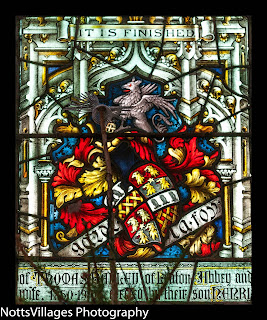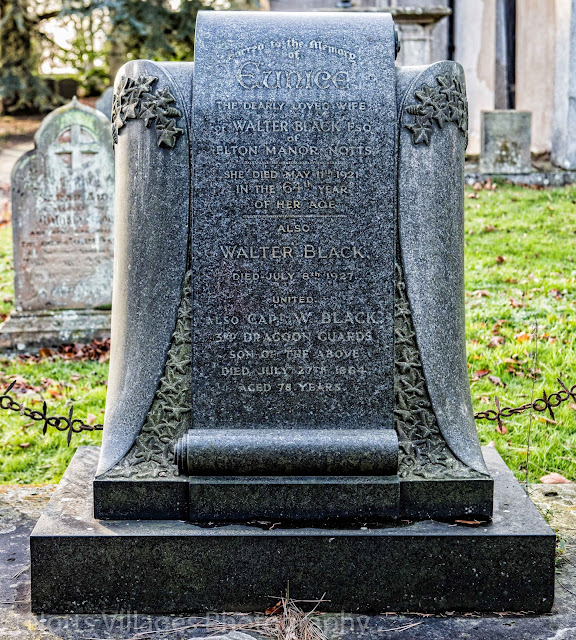 |
| Langar Hall gardens |
 |
| Langar House (home of Samuel Butler). |
After qualifying with a First from St John's College, Cambridge, Samuel was expected to return home to obey his father's wishes. Instead he sailed off to New Zealand where he worked on a sheep farm for a few years. In his spare time he wrote the first draft of his most famous work, "Erewhon". The title is "No Where" backwards (yes, two letters have been transposed!). It was a satire on Victorian society. Aldous Huxley would later acknowledge the influence "Erewhon" had on his own novel "Brave New World".
Butler's second famous work, "The Way of All Flesh", was published after his death as it was semi-autobiographical and as such was not very complimentary to his father!
Butler died in London in 1902. George Bernard Shaw lamented the fact that Butler had not gained more appreciation during his lifetime. His name is still not widely know when compared with D H Lawrence or Sillitoe but in 1998 "The Way of All Flesh" was ranked in 12th place on the list of the Modern Library Top 100 best English - language Novels of the 20th Century.
 |
| Old School House from the church |
 |
| St Andrew's Church |
In those days there was a castle at Langar and the Priory of Ethelburger was just down the road. According to Vatican records "great multitudes" of pilgrims would travel here to be blessed and receive forgiveness for their sins on holy feast days. Both the castle and the priory have long since gone and the village centre has moved .... plague decimated the place in 1665 so the survivors rebuilt nearby.
 |
| Church interior |
A second notable Reverend from the village was Edward Gregory who was a part time astronomer. In 1793 he discovered a comet Gregory-Méchain (C/1793 A1, 1792 II) which he recorded for five nights. It was observed by a number of astronomers at the time but Gregory saw it first.
 |
| Church interior |
Langar Castle was replaced by Langar Hall which sits right next door to the church.
 |
| Langar Hall |
 |
| Lord Scrope's effigy |
In the late 16th century Lord Thomas was Knight of the Shire for Cumberland and Warden of the English West March (The Scottish Borders). In 1596 he caused a major diplomatic incident when he was trying to recapture the outlaw Kinmont Willie Armstrong. The outlaw had previously been illegally arrested on a truce day and imprisoned in Carlisle Castle. Walter Scott (kinsman to the more famous Sir Walter Scott the author) was Warden of the West March on the Scottish side. Scott petitioned Scrope for Armstrong's release. Scrope was new to the post and being unsure what to do with his illegal prisoner he delayed replying. So, thinking diplomacy had failed, Scott took a party of men across the border, gained access to Carlisle Castle (possible through bribery as no casualties results from this raid), found Armstrong's cell and freed him.
Scrope "burnt the towns of Annan and Dumfries to the ground" in attempting to recapture his prisoner. Armstrong was not found but Scrope ended up with 200 prisoners. He ordered them to be stripped naked, chained together on leashes and marched back to Scotland. Obviously there were a few upset people and war between England and Scotland seemed imminent until Walter Scott gave himself up to the authorities. On being taken to London and shown to Queen Elizabeth I she asked him how had he dared to undertake a raid on an English castle.
"What is it that a man dare not do?" was his reply.
He must have impressed his audience .... "With ten thousand such men, our brother in Scotland might shake the firmest throne of Europe!"

The incident didn't interfere with the promotion prospects of either men. Scott would be created Lord Scott of Buccleuch in 1606. While Scrope was made a Knight of the Garter in 1599, the same year Shakespeare was writing Henry V in which an earlier Scrope, Lord Henry Scrope, is last seen being taken off stage to be beheaded. Lord Henry had been a firm favourite of the King Henry V until 1415 when Edmond Mortimer told the King there was a plot to take the throne. Scrope was apparently plotting to murder King Henry and replace him with ... Edmond Mortimer. Some historians believe Edmond was lucky because he got in first and accused Scrope who had in fact been collecting information about the plot in order to bring it to the King. Lord Henry Scrope was not only beheaded but had the added indignity of being dragged through Southampton streets from Watergate to North Gate before being executed. His head was then taken to York to be placed on a spike at the city gate. Can you imagine what sights used to greet travellers to large cities? Bits of dead people rotting away on town walls .... town planners today would be horrified!!
 |
| Langar Hall |
Emanuel married Elizabeth, daughter of the Duke of Rutland. Elizabeth died childless ... Emanuel did not! He had five children by the housekeeper, Martha Jones. Poor Elizabeth!! She had to live in the same house as them all!
The illegitimate children inherited after Emanuel's death. The house passed to the Howe family when Emanuel's daughter Arabella married John Howe. The couple had nine children: four sons and five daughters.
Britain owes a great deal to John and Arabella's grandchildren. George Howe (1725 - 1758) was the son of Emanuel Scrope Howe, Arabella's fourth child. George was described as being the "best officer in the British Army" before he was killed in action! Before this he made major changes to the uniform to make his men more efficient in battle. He also trained his troops to march and how to fight effectively in woodlands. I can agree therefore that such innovations would make him a great officer.
His brother was Richard Howe (1726 - 1799) who began his Royal Navy career as a midshipman at the age of 14 then rose to the top job of Admiral of the Fleet. He was hardly ever at home as he protected Britain's interests in the Channel and in America .... he was in charge of a coastal blockade during the American Wars of Independence. This was not a great success. He claimed he did not have enough ships to be effective but others believed he was a supporter of the colonists (he was a personal friend of Benjamin Franklin). He enjoyed naval victories against the Spanish and the French: he is particularly remembered for the Glorious First of June (1794) during the French Revolutionary Wars.
Like his brother he too introduced innovations to improve efficiency: he improved signalling methods between ships and, his most important change, was the way in which sea battles were conducted. The established strategy was to form a line of ships facing the enemy and blast them from a distance. Admiral Howe changed all that. He ordered his line of ships to sail at the enemy then turn sidways in order to rake and attack the sides of the ships up close. Once the British Navy adopted this approach Britania ruled the waves! In 1797 Lord Howe was awarded the coveted title of Knight of the Order of the Garter: he died of gout two years later and was buried at Langar (he has a monument in St Paul's Cathedral and a wall plaque at his old residence in Bath).
Arabella's third grandchild was General William Howe (1729 - 1814). He, like his brothers, was also a military man. William was Commander in Chief of the British Forces during the American War of Independence. So at one point in history these two brothers were in command of the British Army and the Royal Navy and they both came from Langar!
 |
| Street view near the old school house |
We have mentioned the decline in the number of public houses in the area before so you can imagine our dismay to find ....
 |
| Unicorn's Head |
During the Second World War Langar had a large airbase. Planes still take off from here; they belong to the Langar Parachute School where they will train you for your first jump for only £230. Wandering round the wildflower farm you regularly see .... and hear (it is surprising how far shouts of delight/fear can travel!) .... groups of parachutists floating to earth.
 |
| Langar Airfield |
 |
| Memorial Garden |
 |
| Memorial |
 |
| Notice board at air field |
 |
| The Limes |
 |
| Bayley window |
 |
| Village pond |




















